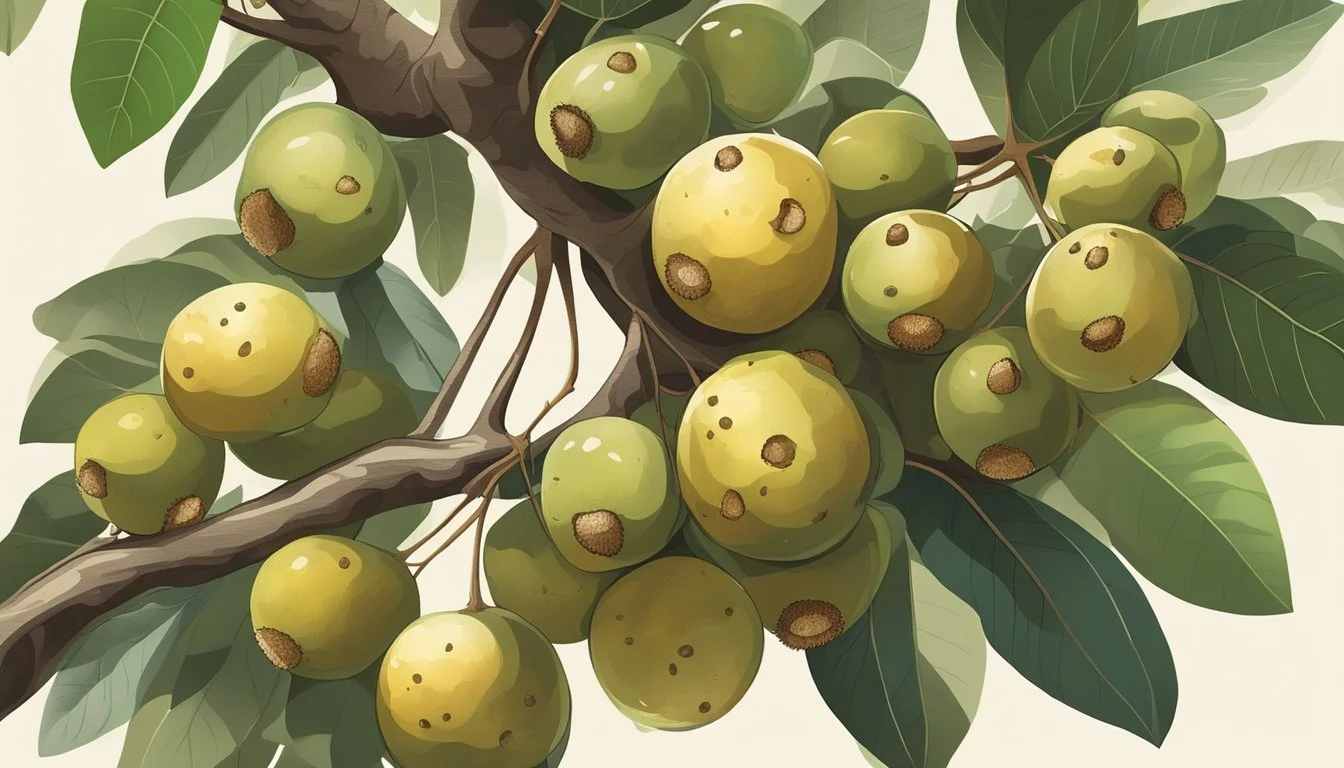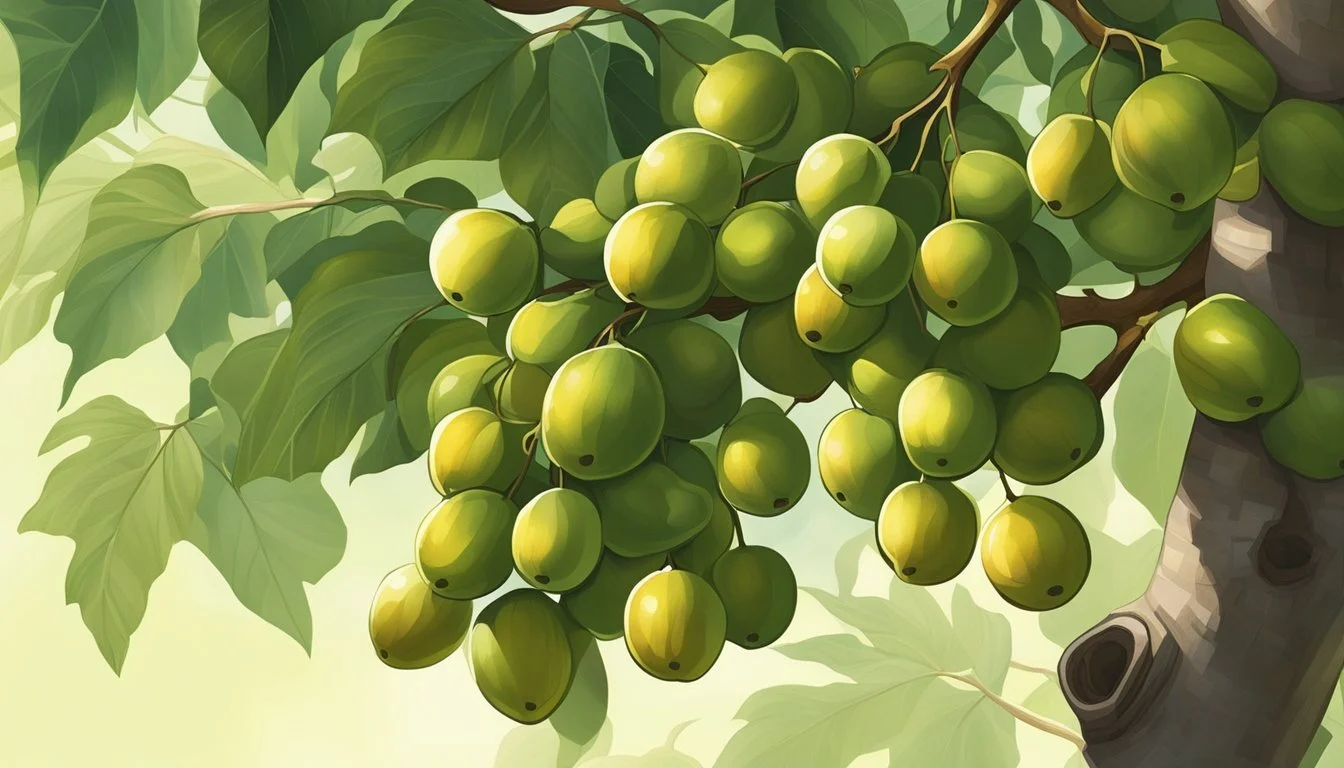How to Tell if a Longan is Ripe
Simple Signs for Perfect Picking
Longan fruit, known for its sweet and aromatic flavor, is a tropical delicacy that has gained popularity across the globe. Recognizing when a longan is ripe is crucial for enjoying the fruit at its best, ensuring a sweet taste and optimal texture. For those who enjoy the succulent taste of longan, understanding the ripening process is key to picking or buying fruit that's ready to eat.
The ripeness of longan is indicated by the color and texture of the skin. A ripe longan typically has a yellowish-brown to light brown skin that feels soft to the touch. Unripe longans have green skin and are firmer, and they may offer a sour or less satisfying flavor. It's important to harvest longans at the right time, as overripe fruits (What wine goes well with fruits?) become mushy and may lose their appealing taste.
Key Takeaways
Ripe longans have yellowish-brown to light brown skin and a soft texture.
The flavor of ripe longan fruit is sweet and aromatic.
Incorrectly stored or overripe longans may lose their desirable qualities.
Identifying Ripe Longans
To determine if longans are ripe, one should examine their color, texture, size, feel, and even fragrance and taste. These indicators help ensure the fruit is at its peak for consumption.
Color and Texture
Color: Look for longans that have transitioned from green to a yellow-brown or reddish-brown skin color, which signifies ripeness.
Texture: Ripe longan should have a skin that is soft yet retains a slightly leathery feel.
Size and Feel
Size: The fruit should be full-sized relative to the average longan, indicating its maturity.
Feel: Gently squeeze the fruit; a ripe longan yields slightly to pressure without feeling mushy.
Fragrance and Taste
Fragrance: Sniff for a subtle, sweet smell which a ripe longan emits.
Taste: If permissible, a sample taste should reveal a sweet flavor with flesh that is translucent and succulent.
The Harvesting Process
The process of harvesting longan is critical to ensure the highest quality fruit. It involves precise timing, careful techniques, and proper post-harvest handling.
Harvesting Techniques
When harvesting longans, one should pick the fruit in large clusters to maintain their freshness. The fruit should be carefully snipped with about 1 foot of the branch to protect the fruit-bearing panicles. It is advisable to use sharp, sanitized pruning shears to make clean cuts without damaging the tree. Efficient harvesting techniques help preserve the quality of both the fruit and the longan trees for future yield.
Timing for Harvest
The ideal time to harvest longans is when the peel turns a yellow-brown hue and the pulp sweetness indicates peak ripeness, generally around late July to early September in regions like Southwest Florida. It is crucial to monitor the color change of the fruit as it is one of the most reliable indicators of maturity. Harvesting too early or too late can affect the taste and storability of the longans.
Post-Harvest Handling
Once harvested, longan clusters should be handled with care to prevent bruising. The fruit should be cooled as soon as possible to extend shelf life and preserve flavor. Clean storage in ventilated containers minimizes the risk of moisture-related decay. It is important to maintain the cold chain during transport to ensure the longans reach the consumer in optimal condition. Proper handling after harvest is vital for maintaining the quality of longan fruits until they are ready for consumption.
Storing and Preserving Longans
When it comes to longans, proper storage techniques can significantly extend their shelf life and maintain their quality. Whether one is looking to keep longans fresh for a short period or preserve them for long-term use, certain methods can help prevent spoilage and ensure the best taste and texture.
Short-Term Storage
For short-term storage, longans remain fresh at room temperature for 1-2 days. If consumers plan to eat them within this time frame, this is a viable option. However, for a slightly longer storage period, placing longans in the refrigerator is recommended. Here, they can last for 2-3 weeks. Refrigerated longans should be stored in a perforated plastic bag or a container with ventilation holes to promote airflow and prevent moisture build-up, which can lead to spoilage.
Long-Term Preservation
For long-term preservation, freezing longans is the most effective method. To freeze longans, one should:
Wash and dry the longans thoroughly.
Spread them in a single layer on a baking sheet lined with parchment paper.
Place the tray in the freezer and freeze for about 2 hours.
Once frozen, transfer the longans to airtight containers or sealable freezer bags.
Make sure to label the containers with the date. Frozen longans will retain their freshness for up to 6 months. Additionally, longans can be dried for extended storage, and properly dried longans have a shelf life of approximately 1 year.
Nutritional Benefits and Uses
Longans are a sweet and juicy fruit cherished for their nutritional value and versatility in various culinary applications. They offer a range of vitamins, minerals, and health benefits, which can be enjoyed in numerous recipes from refreshing fruit salads to exotic desserts.
Vitamins and Minerals
Longans are rich in vitamin C, an essential antioxidant that supports the immune system and promotes vitality. The fruit also contains minerals such as potassium, magnesium, phosphorus, and manganese. In particular, a 100-gram serving of longan delivers about 84 mg of vitamin C, which is above the daily recommended intake.
Vitamin C: 84 mg per 100 grams
Potassium: A significant amount for electrolyte balance
Magnesium: Important for bone health and metabolism
Phosphorus & Manganese: Beneficial for the body's detoxification processes
Health Benefits
The antioxidants present in longan, including vitamin C, contribute to the neutralization of free radicals and may protect the body from oxidative stress. The juicy flesh of longan is not only satisfying but also low in calories, making it a smart choice for people managing their weight. The fruit's dietary fiber content is beneficial for digestive health.
Antioxidant properties: Helps protect cells from damage
Fiber: Supports digestive health
Low-calorie: Ideal for weight management
Culinary Applications
The fruit can be utilized in its fresh form or as juice in a variety of recipes. Longan’s unique flavor profile makes it an excellent addition to:
Fruit salads: Adds a tropical twist
Smoothies: Enhances flavor with its sweet taste
Desserts: Perfect for creating puddings and other exotic sweets
Preserves and jams: Can be cooked down with sugar to be spread on toast or pastries
Longan’s nutritional benefits and diverse culinary uses make it a delightful fruit that can be incorporated into a balanced diet while adding an extra zest to several dishes.
Comparing Longans with Related Fruits
The longan is often compared to other tropical fruits like lychee and rambutan due to similarities in taste, texture, and appearance. Understanding these comparisons helps in distinguishing the longan and appreciates its unique characteristics.
Longan vs. Lychee
Lychee:
Size: Generally slightly larger than longan.
Skin: Rough, red when ripe, and thicker than longan's skin.
Flavor: Sweet and floral, considered more aromatic and flavorful than longan.
Common name: Sometimes called 'Chinese cherry'.
Longan:
Size: Typically smaller, close in size to a grape.
Skin: Smooth, turns from green to yellow-brown when ripe.
Flavor: Subtly sweet, less aromatic than lychee, with a hint of musk.
Common name: Translates to 'dragon eye', due to the appearance of the seed through the translucent flesh.
Longan and Rambutan Similarities
Both longan and rambutan belong to the soapberry family, thus, they share some botanical characteristics.
Tropical Fruit: They thrive in a similar climate and are native to Southeast Asia.
Sweetness: Each fruit delivers a sweet taste that is highly valued in their native regions.
Appearance: When peeled, both reveal translucent, white flesh that is juicy and sweet.
Rambutan:
Size: Larger than both lychee and longan.
Skin: Distinctive hairy appearance, which is why its name translates to 'hairy'.
Flavor Profile: Sweet and creamy, somewhat similar to lychees.
Clearly, while longan, lychee, and rambutan share the sweet, juicy traits of tropical fruits, each has distinctive features in size, skin texture, and flavor profile. These characteristics allow them to be distinguished from one another and celebrated for their unique contributions to the palette of tropical flavors.
Growing Longans at Home
Growing longan trees at home requires understanding their specific climate preferences, soil and watering needs, and pruning and care techniques. Proper attention to these factors promotes healthy growth and ample fruit production.
Climatic Requirements
Longan trees thrive in warm environments, making them well-suited for tropical to subtropical climates similar to their native regions in Southeast Asia and China. They require abundant sunlight to produce blossoms and fruit. For optimal growth, longan trees need temperatures that are consistently above freezing, as they are sensitive to frost. They perform best where they can receive full sunlight for most of the day.
Soil and Watering
The ideal soil for longan trees is well-draining with a slightly acidic to neutral pH. High-quality loamy soil enhances root growth and drainage, reducing risks of root diseases. Regular watering is crucial, especially in dry periods but avoiding waterlogging is key. It's recommended to water deeply but infrequently to encourage deep root development. The addition of organic matter can improve soil structure and water retention.
Pruning and Care
Pruning is essential for maintaining tree structure, removing dead or diseased branches, and encouraging fruit production. Prune longan trees annually to remove inner canopy clutter, which ensures sufficient sunlight reaches the center of the tree. Besides pruning, apply a balanced fertilizer during the growing season to support robust growth. Monitoring for pests and diseases is crucial—early detection and treatment can prevent serious damage. Regular care and preventative measures help maintain tree health and maximize fruit yields.
Frequently Asked Questions
When it comes to enjoying the rich flavor and nutritional benefits of Dimocarpus longan, commonly known as longan, consumers often seek guidance. This section provides clear and accurate information on selecting ripe longans, understanding health considerations, and recognizing different varieties.
Selecting Longans in Stores
One frequently asked question is how to select the best longans when shopping. Ripe longans are typically a yellow-brown color and may have a slightly leathery texture. Look for fruits that are full-sized and avoid those with green skins, which are unripe and may taste sour. For those in regions such as Vietnam and Thailand, where longans are grown, purchasing them during the peak season ensures freshness and optimal taste.
Health Considerations
Consumers also inquire about the health benefits of longans. This fruit is known in Chinese culture for its potential to aid in mental clarity due to its nourishing properties. It is often included in salads and cocktails for a healthy boost, but as with any food, those with allergies or dietary concerns should consult with a healthcare professional before adding longans to their diet.
Longan Varieties
Another point of interest is the variety of longans available. Among the different types, the Chompoo is a popular variety known for its distinctive flavor and is often sought after in local markets and stores. The choice of variety may affect the texture and sweetness, which is important for those looking to incorporate longans into specific dishes or to enjoy them as a standalone snack.





